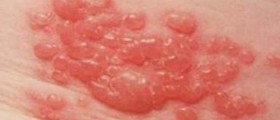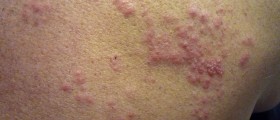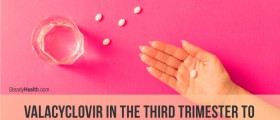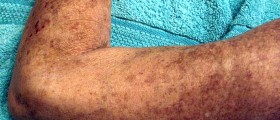
Shingles
Shingles, commonly known as herpes zoster, is a viral infection which features with painful blisters on the skin. This condition develops in people who have had varicella before. Varicella virus does not leave the body but it stays in ganglia of certain nerves. This latent phase of the infection can last many years. In elderly people, those who are suffering from chronic diseases and immunocompromised people the virus reactivates and causes shingles. The blisters are formed in a shape of a band, a strip and affect only localized area of the skin. The disease is not contagious and cannot be transmitted from one person to another.
Symptoms of Shingles
This disease has several stages. The initial symptoms include headache and increased sensitivity to light. Patients may also feel as if they were suffering from the flu. Still there is no increased body temperature.
After initial stage of the disease the skin that is going to be covered in specific changes starts to tingle. This area may be itchy and some patients complain about severe pain. Finally, after a few days tiny little blisters form on the skin. They are grouped and in a shape of a band or a strip. In some people blisters form small irregular areas but they do not spread to the entire body. These blisters contain fluid which may spontaneously drain and this leads to crusting. Blisters withdraw within four weeks. Blisters may turn into scars in some people, especially if they have suffered from secondary bacterial infection of blister. In mild cases, the skin is only affected by the rash and the pain is not so intensive.
Treatment for Shingles
The goal of the treatment is to reduce the length of the disease and prevent certain complications. Medications that are used in shingles are antiviral drugs, painkillers, antidepressants and topic creams.
In the very beginning of the disease patients are administered antiviral medications. If given within 2 days after the onset of the rash antiviral medications can prevent one of the complications called postherpetic neuralgia. These medications include acyclovir, acyclovir or Valacyclovir. They can alleviate the pain and shorten the duration of the disease.
Additional drugs include painkillers such as ibuprofen, Aspirin or acetaminophen. In case of bacterial superinfection patients are given topical antibiotics. Reduction in pain can be achieved by corticosteroids. Still these medications are only administered in patients younger that 50 who have faced a recent outburst of the disease.
If the pain lingers more than a month a patient has most definitely developed post herpetic neuralgia. This complication is treated with antidepressants, topical anesthetics, anticonvulsants and in worst cases with opoids. Post herpetic neuralgia may last for years.
Apart from postherpetic neuralgia in most extreme cases patients may develop long-term complications such as disseminated zoster, herpes zoster ophtalmicus and herpes zoster of cranial nerves. Some of these complications can be devastating and they all require special medications.

















Your thoughts on this
Loading...